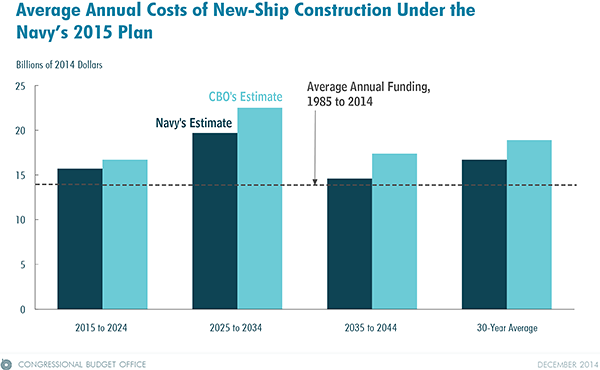December 2014 - The Department of Defense (DoD) submitted the Navy's 2015 shipbuilding plan, which covers fiscal years 2015 to 2044, to the Congress in July 2014. The total costs of carrying out the 2015 plan—an average of about $21 billion in 2014 dollars per year over the next 30 years—would be one-third higher than the funding amounts that the Navy has received in recent decades, the CBO estimates. The Navy’s 2015 shipbuilding plan is very similar, but not identical, to its 2014 plan with respect to the Navy’s total inventory goal for battle force ships, the number and types of ships the Navy would purchase, and the proposed funding to implement the plans.
The Navy Plans to Buy 264 Ships Over the Next 30 Years
The Navy’s 2015 shipbuilding plan states that the service’s overall inventory goal (in military parlance, its requirement) is 306 battle force ships. The Navy’s shipbuilding plan falls short of meeting the service’s inventory goals for some types of ships in some years, although generally the shortfalls are smaller than in previous years’ plans.Under the 2015 plan, the Navy would buy a total of 264 ships over the 2015–2044 period: 218 combat ships and 46 combat logistics and support ships. Given the rate at which the Navy plans to retire ships from the fleet, that construction plan would not achieve a fleet equal to the inventory goal of 306 ships until 2019 under new rules for counting ships that the Navy implemented this year or until 2022 under the old counting rules.
CBO Estimates the New-Ship Construction Costs in the Navy’s Plan At About $19 Billion per Year
The Navy estimates that buying the new ships specified in the 2015 plan would cost $500 billion over 30 years, or an average of $16.7 billion per year—slightly less than the costs of the 2014. (Unless otherwise indicated, all dollar amounts in this report reflect budget authority in 2014 dollars.) Those figures apply solely to the construction of new ships—the only type of costs reported in the Navy’s 30 year shipbuilding plan. Other activities typically funded from the Navy’s budget accounts for ship construction—such as refueling nuclear-powered aircraft carriers and outfitting new ships with various small pieces of equipment after the ships have been built and delivered—would, in CBO’s estimation, add $1.9 billion to the Navy’s average annual shipbuilding costs under the 2015 plan. (Between 2009 and 2014, the cost of those other activities averaged $1.9 billion per year.) Including those extra costs would increase the average annual cost of the Navy’s 2015 plan to $18.6 billion, slightly less than the cost of the 2014 plan.Using its own models and assumptions, CBO estimates that the cost of new-ship construction in the Navy’s 2015 plan will total $566 billion over 30 years, or an average of $18.9 billion per year. Including the costs of refueling aircraft carriers and other items, such as outfitting new ships, raises the overall average cost of the Navy’s plan to $20.7 billion per year, CBO estimates. That figure is slightly less than CBO’s estimate of the average annual cost of the Navy’s 2014 plan.
CBO’s estimate of the cost of new-ship construction in the Navy’s 2015 shipbuilding plan is $66 billion, or 13 percent, higher over the next 30 years than the Navy’s estimate. CBO’s estimate is 6 percent higher than the Navy’s for the first 10 years of the plan, 14 percent higher for the following decade, and 20 percent higher for the final 10 years (see Figure 1 below). The difference widens over time in part because the Navy, in its constant-dollar estimates and in contrast with CBO, does not appear to have accounted for the fact that costs of labor and materials have traditionally grown faster in the shipbuilding industry than in the economy as a whole. Also, the Navy and CBO used different estimating methods and assumptions regarding the designs and capabilities of future ships. CBO’s estimate of the total cost of the Navy’s plan over the next 30 years, including all ship construction activities, is 11 percent higher than the Navy’s estimate.










